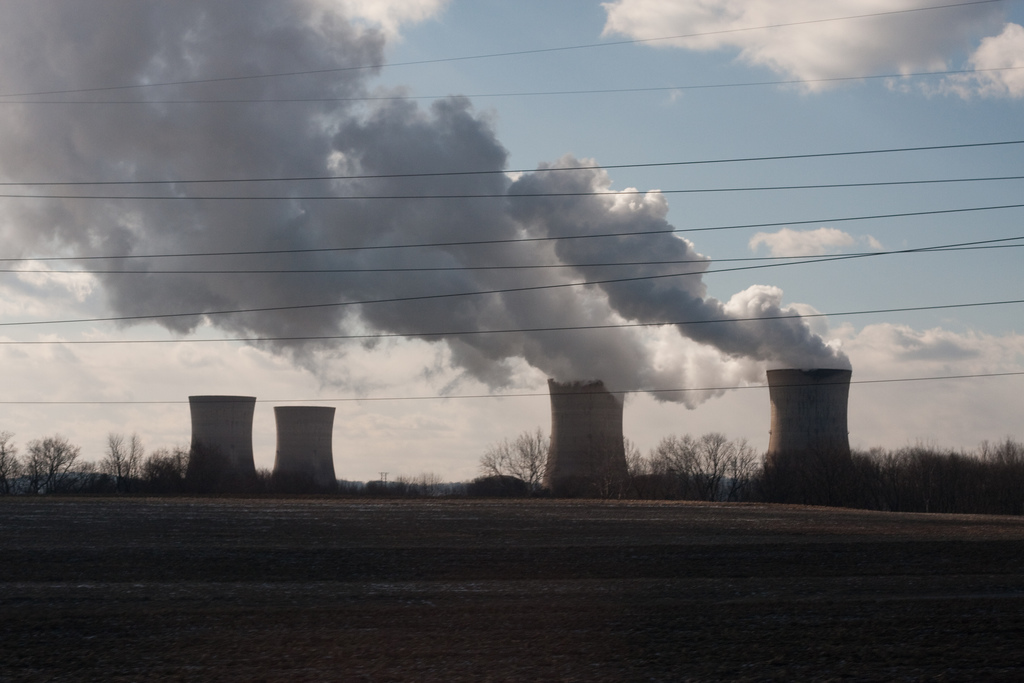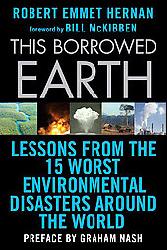
Robert Hernan’s This Borrowed Earth: Lessons from the Fifteen Worst Environmental Disasters around the World studies over a dozen environmental disasters, but one is particularly close to Hernan. In the early 1990s, Hernan served as legal counsel for the State of New York in the Love Canal trial, against the chemical company that turned the Niagara Falls neighborhood into a toxic waste site – thick black goo bubbled up in backyards, toxic chemicals seeped into basements, and an elementary school shut down. During the case, which was settled for $100 million each in state and federal costs, Hernan kept a journal, using his notes along with new research to explore the incidents whose names – Chernobyl, Bhopal, Three Mile Island – have become shorthand for environmental danger and unscrupulousness. Below, Hernan explains what makes an environmental disaster, why the line between environmental and natural disaster is blurring, and what it means for policy.
Q. What is the difference between an environmental and natural disaster?
A. Natural disasters arise from natural forces, such as floods, tornadoes, hurricanes, tsunamis, and volcanic eruptions. These natural disasters can, and often do, wreak havoc over a wide area and cause deaths in the hundreds, thousands, and even hundreds of thousands. They tend to happen suddenly, have a severe impact, and then recede quickly, in hours or days.
Environmental disasters, in contrast, arise from manmade forces. They pollute the environment – air, water, or land – for months, decades, or, in the case of some radiation elements, thousands of years.
Q. What are some environmental disasters you study here? How did you go about selecting them?
A. We covered everything from Japan in the 1950s to global climate change today. First there had to be sufficient research material in English. Then I wanted a sampling of the worst disasters throughout the world, to show the problem wasn’t confined to any one country or region. Then I wanted to include disasters covering different environmental media – water, air and land – and different pollutants – toxic chemicals, oil, nuclear materials.
Q. What are the consequences of these environmental disasters, in terms of the environment, our awareness of it, and our policies on it?
A. Environmental disasters sometimes kill people outright, as at Bhopal, India, where thousands died almost instantly after an explosion at a chemical plant spread a cloud of toxic fumes over the city. The more distinguishing characteristic of environmental disasters, however, is that they often produce their worst health effects only months or years afterward. It was many years after the 1986 nuclear disaster at Chernobyl, for example, that children began to suffer from cancer of the thyroid as a result of their exposure to radioactive materials. The consequences of environmental disasters are in many ways more insidious than those of natural disasters.
 The consequences often remain uncertain. Some are visible, such as the fires in the Kuwaiti oil wells, or the dense fog that blanketed London in December 1952. But with the by-products of modern technology, the harmful substances are often invisible, such as the dioxin in the soils of Times Beach or the toxic chemicals dumped into Love Canal and the Rhine River. In many situations, the full reach of toxic chemicals cannot be determined. At Seveso and Love Canal, authorities could not accurately identify how far into the community the dangerous material had spread.
The consequences often remain uncertain. Some are visible, such as the fires in the Kuwaiti oil wells, or the dense fog that blanketed London in December 1952. But with the by-products of modern technology, the harmful substances are often invisible, such as the dioxin in the soils of Times Beach or the toxic chemicals dumped into Love Canal and the Rhine River. In many situations, the full reach of toxic chemicals cannot be determined. At Seveso and Love Canal, authorities could not accurately identify how far into the community the dangerous material had spread.
The refusal to devote sufficient resources to environmental protection efforts is not just a policy choice. It is not just a means of rewarding interests that are tied to polluting technologies or industries. More dangerously, it is the result of an inability or failure to imagine the consequences of our actions. As these stories demonstrate, those responsible for controlling lethal substances are often the ones who fail to imagine that their actions could put people at risk, or they ignore the enormity of the risk. The chemical company in Minamata refused to admit or accept that its waste could be causing the devastating disease inflicted on nearby fishing villages. In other cases, bound to routine, nuclear operators could not believe the readings on their instruments when they signaled critical dangers.
Q. Why do you think the line between environmental and natural disasters may blur in the future? Is it already happening at all?
A. In his Foreword, Bill McKibben perceptively notes that, in the years to come, the line between natural and environmental disasters will blur. As a result of human actions, global climate changes will cause sea level rises and intensify hurricanes and other extreme weather events. These “natural” disasters will no longer be the work of nature or God but will show the hand of humans. It is difficult to identify an extreme event now, either in its origin or intensity, as specifically attributable to global climate change, and just when the conversion from natural to man-made disaster will occur is uncertain. That it will happen is certain.
Q. Will this blurring make it harder for us to be shocked by environmental disasters, as we were with, say, Three Mile Island or Chernobyl?
A. That’s an interesting point that you make. I think that will depend on whether people accept responsibility for their own contribution to global climate change, and the impacts of climate change. Because environmental disasters are manmade, there is almost always someone to blame, usually the polluter or an ineffective government agency. Not surprisingly, we react differently to suffering that is inflicted by other people rather than by natural forces, especially when the suffering results from a company’s callous failure to protect the environment in which we all live. If we are injured or lose property as a result of a flood or hurricane, we don’t get angry at the water or wind. But if a company’s chemicals contaminate our water and threaten our health and that of our children, we get damned angry. And we want the threat stopped, by the company or by the responsible government agencies. The extent to which we ourselves cause the disaster may complicate the response and make it harder to be shocked. We’re usually more generous in forgiving ourselves than others.
Q. Did the “shock value” of disaster motivate political/regulatory action? How will the changing nature of disasters change our policy or regulatory reactions?
A. Almost every disaster has been followed by calls for government regulation and enforcement. The London fog of 1952 led to the British Clean Air Act of 1956, which finally addressed the long-term fouling of London’s air. Love Canal was instrumental in the passage of the 1980 U.S. Superfund law, which provided funds to clean up abandoned toxic waste sites and aggressive enforcement powers to make sure polluters pay for cleanups. The careless disposal of dioxin materials from Seveso led to the European Union’s Seveso Directive, which now regulates the transnational shipment of toxic wastes. It often takes an environmental disaster to overcome the normal stagnation and vested interests that block regulatory reform.
You ask a tough question about how the changing nature of disasters might affect our policy or regulatory reactions. The real question for trying to prevent future environmental disasters that likely will result from our individual and collective greenhouse gas emissions is whether we have to persuade people to make lifestyle changes. It’s hard enough to get people to delay gratification when you ask them to give up some pleasure now for greater pleasure later. It’s a lot harder to ask people to sacrifice now for benefits that affect future generations. One thing that might help is the recognition that the climate change impacts that are predicted to occur 50 to 100 years from now will actually affect the people now being born since medical and healthcare advances will keep those born now alive for close to 100 years. So when you think about what the world will be like 100 years from now, be sure to look around at the new infants before you dismiss any concerns about that future.
Q. After all these disasters, how are corporations handling environmental responsibility? How has it improved over time, and what do you think still needs to happen?
A. Companies, especially the large ones, have learned that irresponsible actions that cause environmental damage will cost them, often in amounts that far exceed what it would have cost to be more protective of the environment. It is the tough environmental laws and regulations passed – often in response to these disasters – that taught them this lesson. But it is citizen activism that is critical in constantly reminding the companies of these lessons. And that same citizen activism is necessary to watch over the governmental agencies that are supposed to be serving as watchdogs.
*Photo courtesy Tom Harpel.




Send A Letter To the Editors